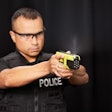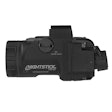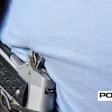Small easily concealed pistols have become some of the best-sellers in the firearms market. These pistols are designed for civilians who have concealed carry permits, but they are also being marketed to cops as off-duty and backup tools.
However, in order to make these pistols so compact, many manufacturers have chosen to chamber them for the .380 ACP cartridge. Which has its drawbacks as a combat round.
That's why we are now seeing a wave of new subcompact pistols chambered for the more powerful 9mm cartridge. An excellent example of these small but powerful pistols is the new SIG Sauer P290.
Lots of Options
While at first the P290 appears to be a downsized version of the company's P250 Modular pistol, it is in fact a completely new and simpler design intended for one purpose alone: concealed carry. Accordingly SIG has reduced its dimensions to what might be considered the barest minimum for the 9mm Parabellum cartridge.
Let's begin our examination at the top and work our way down.
The slide is made from machined steel and features a square profile reminiscent of the P250. Buyers have a choice of a Nitron finished or stainless steel slide. The top of the slide is adorned with large, easy to see three-dot sights and Tritium night sights are optional.
A large extractor ensures positive extraction of spent cases while a generously sized ejection port ensures they get out of the way quickly. Square cut grasping grooves make it easy to retract the slide to chamber a round, or clear a malfunction, even with wet hands or if wearing gloves.
As is almost standard operating procedure today, the P290's frame is made from polymer although it differs from its contemporaries in one way. The polymer grip panels are removable and SIG offers replacement panels in either aluminum or wood for those who might care to personalize their pistols.
The pistol is fed via a six-round, single-column magazine, the base plate of which has swells on both sides to allow the shooter to pull it out of the grip if necessary. The trigger guard is of generous proportions, and the magazine release button is located in the "proper" position for easy manipulation.
SIG offers the P290 with the option of an integral laser sight that can be mounted in front of the trigger guard and is activated by ambidextrous buttons on the sides of the sight body.[PAGEBREAK]
Double-Action-Only
The P290 is a hammer-fired design and, as behooves a pistol designed for concealed carry, the hammer is bobbed to provide a smooth, snag-free outline. It has a double-action-only (DAO) trigger mechanism but does not have double-strike capability. In case of a misfire, the slide must be retracted slightly and released to reset the trigger mechanism.
Shooters familiar with other SIG pistols will quickly see that the P290 has a locking system that is common to most SIGs. The barrel hood moves up into and bears on the front edge of the ejection port, locking the barrel and slide together. Upon firing, the slide and barrel move rearward a short distance until the barrel is cammed down, allowing the slide to continue to the rear, extracting and ejecting the spent cartridge case. A dual recoil spring under the barrel then pulls the slide forward, stripping the next round from the magazine and chambering it as the slide goes into battery. A cone-shaped muzzle ensures that the barrel is positioned correctly in the slide for enhanced accuracy and reliability.
Unlike many of the new breed of mini-9mm pistols, the P290 does not have a manual safety, relying instead upon the long trigger stroke. As this system has proven quite satisfactory on double-action revolvers for more than a century, SIG apparently didn't see any reason to complicate matters.
Accurate for Its Size
SIG kindly provided me with an early production P290 to evaluate. Quality of materials and assembly were as to be expected from a company with SIG's reputation. It was well balanced and pointed well. The trigger pull was rather heavy with a definite staging about halfway through the stroke, although I assumed this would smooth out with use. My other concern was that the attenuated grip left the little finger of my shooting hand dangling in the air.
I test fired the P290 for accuracy from a Caldwell Matrix rest at a measured 15 yards with four brands of factory ammunition. (See "Shooting the SIG Sauer P290" on page 24.)
While it printed more or less to point of aim, the heavy trigger pull required a bit of concentration and nursing along. As has been my experience with most compact 9mm pistols, the P290 showed a preference for heavier, slower moving bullets and performed best with Black Hills' 147-grain load.
Myself and my brother Vince, a deputy with the Lonoke County (Ark.) Sheriff's Department, ran the P290 through a series of offhand drills on a combat target at seven yards. As we did not have a suitable holster, we began each drill with the pistol in the low ready position.
We performed the following drills:
[PAGEBREAK]
1. Raise pistol and fire six rounds on target. "Head" shots only.
2. Raise pistol and double-tap target. Perform a combat reload and repeat. This drill was performed three more times and on the last run the pistol was fired with an unsupported grip.
3. Raise pistol and fire six aimed shots on target. Perform a combat reload and then repeat.
First Impressions
By the end of the day, Vince and I had run about 300 rounds through the P290, which allowed us to make the following observations:
The P290 pointed naturally, the sights were excellent and, once we had the measure of the trigger, we were able to put rounds where we wanted them. And while the trigger pull smoothed out somewhat by the end of our shooting session, the staging was still present.
Because of its short grip, frame recoil control was not what one would have hoped for and I actually found the pistol more comfortable to fire with an unsupported grip. While the front and rear straps and grip panels are aggressively textured, we both felt something else was needed.
When I expressed this concern to a SIG representative I was informed that future plans call for the P290 to come with a spare eight-round magazine with a sleeve that approximates the external contour of the grip. Such magazines will provide a full, three-finger grip without compromising concealability to any degree and significantly improve recoil control in the bargain.
The magazine release projects out rather far from the frame and unless you consciously hold the thumbs of your shooting and support hands away from it, it can be activated accidentally, dropping the magazine down far enough to where the slide cannot pick up the next round. Shortening or rounding off the button would cure this problem without adversely affecting reloading speed. Lastly, the magazines proved difficult to load to capacity and by the end of the day Vince and I had pretty sore thumbs.
I found the P290 to be a well-made, simple-to-operate, and concealable pistol but, as with most new designs, there remain a few bugs to be worked out of it. Knowing SIG as I do, I'm sure we will see this happen in short order.
Paul Scarlata has served as an auxiliary police officer and is a frequent contributor to POLICE.
SIG Sauer P290 Subcompact Pistol
Caliber: 9mm Parabellum
Action: Double action only
Overall Length: 5.5 inches
Barrel Length: 2.9 inches
Height: 3.9 inches
Width: 1.1 inches
Weight: 20.5 ounces
Construction: Slide: Nitron finished or stainless steel Frame: Polymer
Magazine: 6 rounds, single-column box
Sights: Front: Blade with white dot
Rear: Dual white dots
Grips: Polymer
Features: Optional integral laser sight, optional night sights, carrying case, spare magazine, removable aluminum and wood grip panels, lock, owner's manual
Price: $758 ($828 with laser)

















